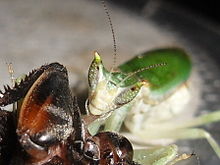Small flower mantis
| Small flower mantis | ||||||||||||
|---|---|---|---|---|---|---|---|---|---|---|---|---|

Small flower mantis ( Pseudoharpax virescens ), female |
||||||||||||
| Systematics | ||||||||||||
|
||||||||||||
| Scientific name | ||||||||||||
| Pseudoharpax virescens | ||||||||||||
| ( Serville , 1839) |

The small flower mantis ( Pseudoharpax virescens ) is a fishing insect from the Hymenopodidae family .
features
Females reach a body length of 30 millimeters, males of 20 millimeters. This makes the small flower mantis one of the smaller species of fishing horror. The upper wings are predominantly green in color, the lower wings are, like many praying mantises, translucent. The abdomen itself is white with light green delimitations of the segments. The thorax is also greenish, but white on the edge. The head is almost entirely white, only green between and behind the eyes. The legs are partly pale green in color.
male
The males can already be recognized in the subadult larval stages by their thickened and long antennae. The elongated, slender physique and the long wings protruding beyond the abdomen are characteristic of adult males. Males are very good fliers. They usually fly at night and can be attracted by light traps . Chemoreceptors on the antennae are used to detect the females.
female
As with most fishing horrors, the adult females can be clearly distinguished from the males mainly by their size and the full abdomen with short wings. The antennae of the females are significantly shorter and thinner than those of the males, they have no thickening. Viewed from above, the small flower mantis has two eye spots on the white background of its abdomen, which has led to the English name Spotted-eye Flower Mantis .
Larvae
The early larval stages of this species are very small and feed on tiny insects. They have a gray camouflage color and look very similar to ants in physique. Some scientists consider this to be an expression of Batesian mimicry .
Occurrence and habitat
The small flower mantis occurs in Africa , in the countries Ethiopia , Burkina Faso , Ghana , Guinea , Kenya , Niger , Nigeria , Senegal , Somalia , Togo and Uganda .
It prefers savannahs , where it mainly resides in the herb layer on leaves and flowers. Due to its small size, it mainly catches smaller insects, including flies and not yet fully grown grasshoppers . For example, you can find them on a regular basis Vernona guineensis , a daisy family , feed on the many insects, including fruit flies of the genus Stamnophora . In terms of size, these flies fit well into the prey pattern of the small fishing insect.
Reproduction
Mating takes two to three hours. The female then lays 15 oothecs . From these 20 to 30 nymphs hatch after 4 weeks . It takes three months for the animals to become adults through the last molt . The males are sexually mature around 10 days after the imaginal molt, the females after around 14 days. The life cycle is only a few months.
Taxonomy
The small flower mantis was described in 1839 by Jean-Guillaume Audinet-Serville in the volume Orthoptera of the Histoire naturelle des Insectes as Harpax (Creobroter) virescens . At that time the catching horrors were still counted among the locusts.
Subspecies
There are two subspecies of the lesser flower mantis:
- Pseudoharpax virescens virescens (Serville, 1839)
- Pseudoharpax virescens centralis (La Greca, 1954)
gallery
Female with a captured grasshopper
Individual evidence
- ↑ Dominique DUVIARD: Recherches écologiques dans la savane de Lamto (Côte d'Ivoire): L'entomocoenose de Vernonia guineensis . La terre et la vie, 1, pp. 80-93, 1970, p. 72
- ↑ http://mantodea.speciesfile.org/Common/basic/Taxa.aspx?TaxonNameID=1096
literature
- Jean-Guillaume Audinet-Serville : Histoire naturelle des Insectes. Orthoptères. Par M. Audinet Serville. Librairie encyclopédique de Roret, Paris 1839, p. 162 (first description)
- Reinhard Ehrmann: Mantodea: praying mantises of the world. Natur und Tier Verlag, Münster 2002, ISBN 3-931587-60-6
- Francesco Lombardo New and Little Known Mantodea from Eastern and Central Southern Africa. Journal of Orthoptera Research, 6, pp. 69-81, 1997, p. 80






